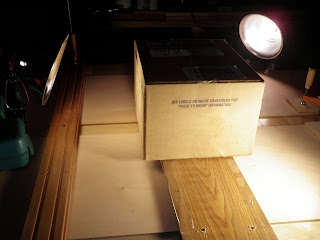


Last time, we saw how mating bevels were cut prepatory to joining two pieces of plywood to achieve a length longer than the standard 8-feet. Here we see the glue-up. I use epoxy, as it is tough and strong. Others have had success with weldwood, resorcinol, and even contruction adhesive out of a tube. I'm comfortable with epoxy, having used it for decades. Comfortability with an adhesive's properties and working times is almost as important as what glue to use, as you can "blow" a glue up if the unexpected happens--like the glue setting up before you've aligned your pieces.
Here we see the mating bevels first slathered with straight epoxy, which is allowed to soak into the grain. This prevents a "glue-starved" joint. After a few minutes, I apply a thickened mixture, adding colloidal silica to the glue mix, and paint that on. The planks are flipped, the bevels mated and all is clamped, weighted and screwed to the work table. I applied lights for heat, to help the cure. Note that the clamping bar (the shelving) and the work table are covered with polyethylene film to prevent sticking to the work.
I'll leave this clamped up for at least a day, then stow the planks in a safe place while I glue up the bottom. This design uses a cool technique for getting an 11-foot boat bottom out of a single 8' sheet of ply.....




No comments:
Post a Comment